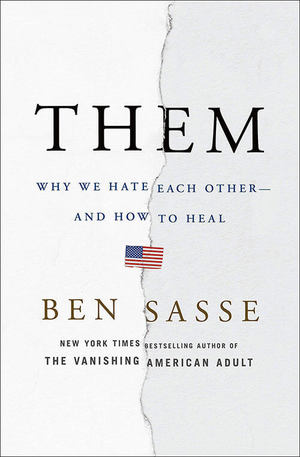As a refugee from daily journalism, I read books about politicians, but not a lot by them. Such books have always seemed self-aggrandizing or ranting or unfounded in fact. I know I’m wrong, but I have too many other good things to read to waste my time weeding through the rest.
Thanks to an interview with the author on NPR, Ben Sasse’s Them: Why We Hate Each Other — and How to Heal became one of the exceptions to my rule.

I hadn’t known a lot about Sasse beyond sound bites. By his own declarations (including in this book), the Nebraska Republican is one of the most conservative members of the U.S. Senate. And I admit that from time to time I fall into the trap of using the current politispeak shorthand of “conservative” and “liberal” as code for the extreme and sometimes wacky ends of the political spectrum. (I tend to be moderate in my views and occasionally change my mind, which means I fail all the “ideological purity tests” and rarely have friends on a lot of issues.)
But I really liked the thoughtful way Sasse answered the radio host’s questions, and especially how he didn’t take the cheap shots we often hear in political interviews. So, on my to-read list he went.
I’m pleased to report that Sasse’s book is just as thoughtful and honest as that interview, and while I don’t always agree with his viewpoint, I understand it. And the subject he explores in this book — just how downright nasty and tribal everyone seems to be these days, and why, and what we might do about it — is an important one.
These qualities shouldn’t be too much of a surprise, really. Sasse, 47, studied at Harvard, Oxford and Yale (where he got his doctorate), has taught history and served as president of Midland University in Nebraska (where he grew up).
At the risk of oversimplifying, Sasse argues that the breakdown of civility comes from the loss of shared communal activities and common experiences and goals. You know: You root for Notre Dame, I root for Purdue, but in the end, we both need to put food on the table, that sort of thing. Them considers the possible — in most cases, I’d say definite — causes for this fracturing of American community spirit. Some won’t come as much of a surprise.
Social isolation is one. Social media allows us to put forth an image of ourselves that is pure fun, successful, with no hint of common struggles. As a result of these misconceptions about each other’s lives, we all feel lonelier — like we have less in common with our friends and family than we actually do. (Oh, look, they’re going to Disney again, and I have to put brakes on the car.) We hole up in our homes, binging on TV shows during a heat wave; meanwhile, we aren’t checking on our dying neighbors. (That sounds like a big leap, but Sasse uses the fatal Chicago heat wave of 1995 as an extreme example of where a breakdown in community and neighborliness can go. He lays it all out more carefully than I can here.)
He spends considerable time on media influences, primarily television networks such as FOX News, CNN and MSNBC. This section was particularly interesting for me, given the 16 years I spent in newspapers. Sasse spares us the typical conspiracy theories, hidden agendas and incitement of violence against the media that we hear too much these days. Instead he offers a well-reasoned look at the forces that shaped these large media outlets, including the appetite of a 24-hour news cycle that needs constant feeding, ratings and the resulting advertising revenues. In the end, he is a fan of a free press, and it’s hard to argue with his larger points. Whether he and I would agree on what truthful, objective reporting entails in particular cases, I don’t know, but I suspect we would mostly agree.
Sasse presents some of what he laments as lost — and which, he says, America longs for — a little too neatly. What happened to everybody meeting at the Little League field? I would say that overzealous, win-at-all-costs-you-lazy-seven-year-olds parents and coaches should take most of the blame, just for starters. Where’s the hometown-gym-on-a-Friday-night feeling? Again, not everyone likes sports. There’s more going on beneath our social woes than simply saying nobody goes to watch the high school football team anymore, or to suggest that if we all did that, everything would be fine — that racism and classism would melt away, and so what if that guy in the front row slept with your wife, go team!
Sasse knows this, though, and it is unfair to criticize one book for not having all the answers wrapped up in a few hundred pages.
Near the end of the book, he offers suggestions that amount to the old journey-of-a-thousand-miles, and he admits it may sound a little naïve: Start with one step, the small gesture that leads to bigger actions that can begin to rebuild the kind of community that so many of us fear is lost and may never return. Sasse offers ready examples: Volunteer at a homeless shelter or your church, if you have one, or read to people at a retirement home. I don’t think this is disingenuousness on the senator’s part. He’s trying to evoke a larger concept of unity around common experiences, and he mostly succeeds. Sasse’s vision of community might seem to be a tall order, but I think it’s one we should all agree on.
Mike Petrucelli is a freelance writer who lives in Plymouth, Indiana.